This post may contain affiliate links. Please read our disclosure policy.
Learn how to make Hokkien bak chang in a pressure cooker or with boiling method. The recipe is a no fuss but with same great taste. Also find the step-by-step on how to wrap bak chang.
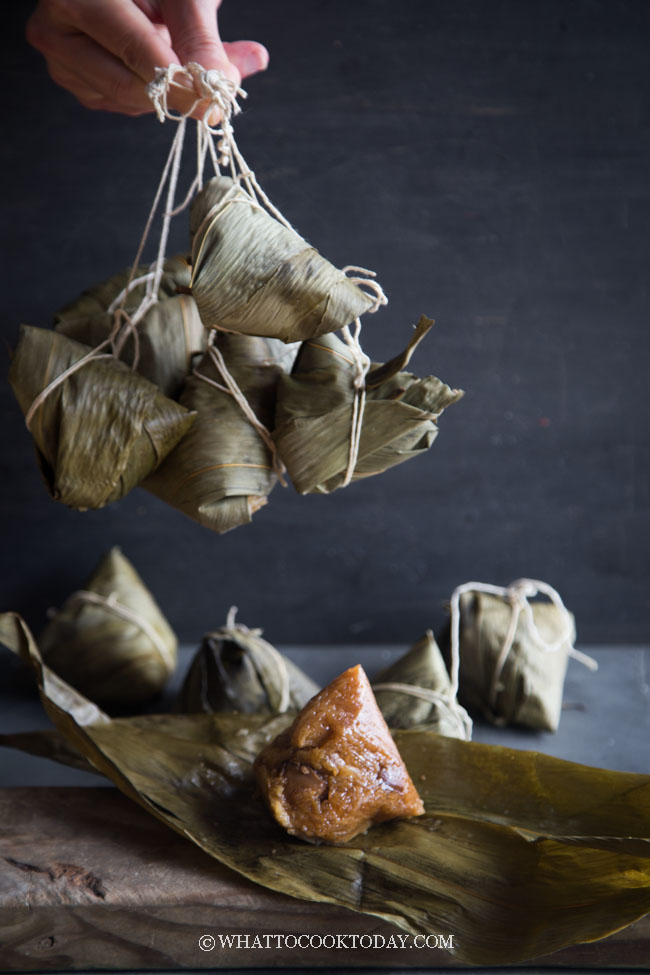
I’ve never imagined making zongzi or bak cang in Hokkien dialect, on my own. I mean this was something I took for granted. Either my mom would make them or my aunt would make some or my dad would buy some. Regardless, we always had some to eat. They are also available at most Asian grocery stores too, however, I always miss the one I had at home. Zongzi is traditionally eaten at the Dragon Boat Festival on the fifth day of the fifth lunar month (confused yet ? don’t worry about the day and the month, just focus on the food).
WHAT IS DRAGON BOAT FESTIVAL?
The Dragon Boat Festival is the commemoration of the death of the great poet and official of the state of Chu, Qu Yuan, during the Zhou dynasty. He wrote a great deal of poetry during his life and serve in high offices. He was accused of treason during the warring states period. He felt despair and Qu Yuan drowned himself in the Miluo river in northern Hunan. People who admired Qu Yuan made rice parcels and threw them into the river in the hope that the fish would not consume Qu Yuan’s body and ate the rice parcels instead.
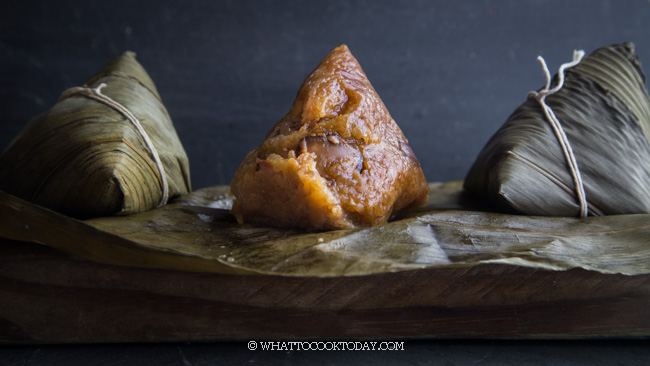
MY GRANDMA’S STORY OF DRAGON BOAT FESTIVAL
The version I’ve heard, told by my late grandma, was that zongzi is made and used as one of the offerings for deceased people. Zongzi made with glutinous rice is sticky in nature, so it will be sticky when eaten using hands. Some Chinese believe that the deceased person isn’t aware that he has passed away and hence, when he eats the glutinous rice cones on the 7th day of his passing, his hands are sticky and when he washes hands, he will see his fingernails that have turned black (rotten). He will then know that he has deceased. So, the zongzi is used to help them realize that they have passed away and rest in peace. Interesting story!
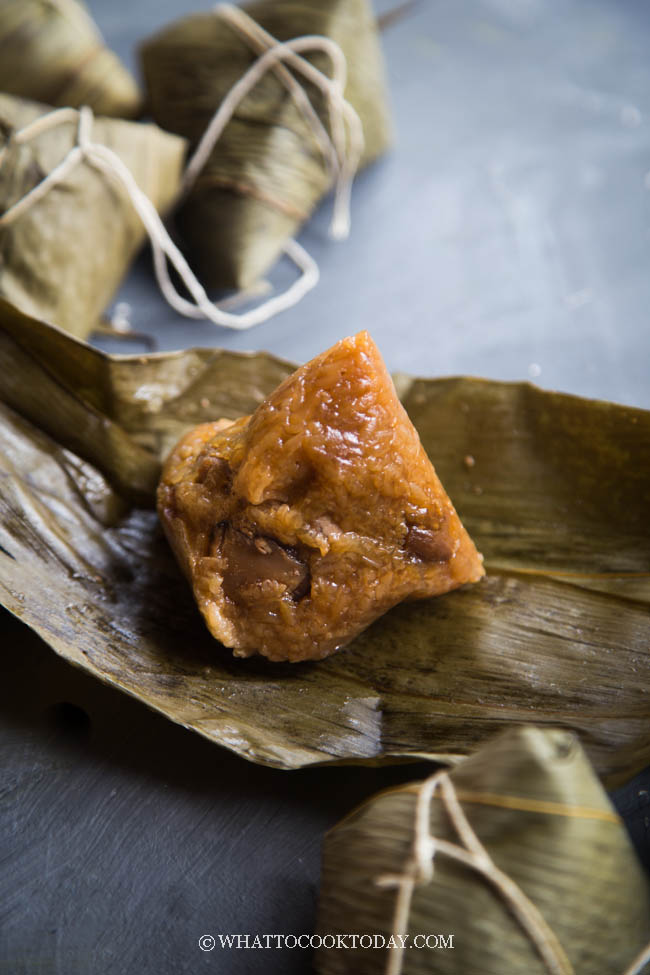
Despite all the stories out there, no one really knows for sure. I just know that Zongzi is eaten all over the world, especially in Asia. Of course, as the Chinese immigrated to other countries, this culture is carried along and now is eaten in other parts of Asia and has been adapted to local taste too.
DIFFERENT KINDS OF STICKY RICE DUMPLINGS (BAK CHANG)
SAVORY VERSIONS: There are Cantonese bak chang, Hokkien bak chang, Teochew bak chang, Hainanese bak chang, and Nyonya Chang as far as I know. All are made with glutinous rice and wrapped in bamboo leaves but with different variations in filling.
SWEET VERSIONS: alkaline dumpling (kee chang), sago dumpling
HOKKIEN BAK CHANG
My Dad’s family is Hokkien and needless to say, Hokkien bak chang is what I grew up eating. Even though my mom’s family is Teochew, but I’ve never tasted Teochew bak chang before. Teochew bak chang has both sweet and savory filling.
Hokkien bak chang is much darker in color because dark soy sauce is used and I know some has black-eyed peas added to the filling. I didn’t use that. The meat filling is also cooked in five-spice powder and chestnuts and salted egg yolk are added. The glutinous rice grain is usually stir-fried in five-spice powder and dark soy sauce for that dark appearance.
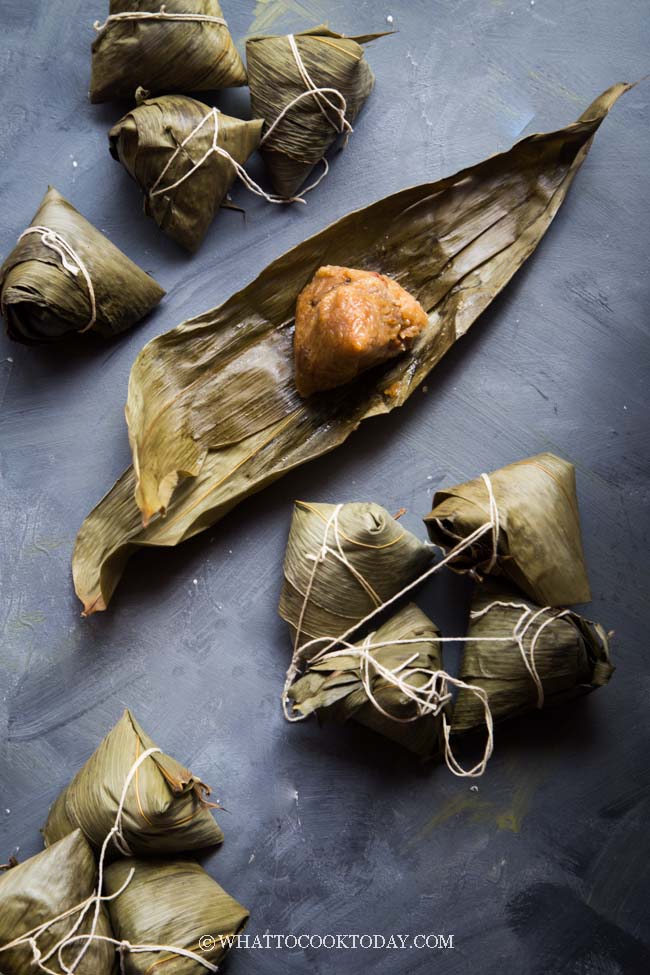
PRESSURE COOKER SAVES COOKING TIME
After the success with making Easy no-wrap bak change, I mustered up some guts to try out the traditional wrap bak chang. The Nyonya chang I made with pressure cooker turned out really great too. I simplified the recipe to make it less intimidating but I can assure you it still has the same great taste
1. NO SOAKING OF STICKY RICE
This is probably one of the best parts for me. The glutinous rice can be cooked in the pressure cooker without having to be soaked for hours or overnight. If you plan to boil them, you still need to soak the rice for at least 4 hours
2. REDUCTION IN COOKING TIME
By using a pressure cooker, you save time significantly from regular 2- 2 1/2 hours of boiling down to 50 minutes!
STEP-BY-STEP HOW TO MAKE AND PREPARE BAK CHANG
1. STIR FRY THE RICE
After soaking the rice (if you are not using a pressure cooker to cook the bak chang), drain all water. Preheat a large wok or skillet. Add cooking oil. Stir fry garlic until really fragrant. Add the rice followed by all the seasonings.
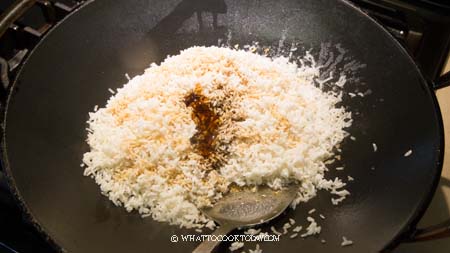
Stir fry the rice until it picks up all the seasonings and the rice turns slightly sticky. Remove from the heat and let it cool down before using it to wrap
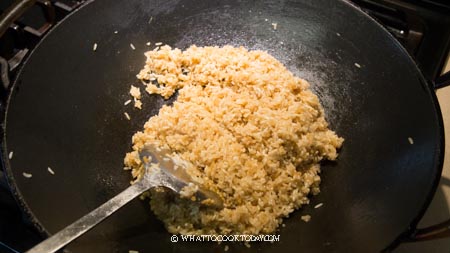
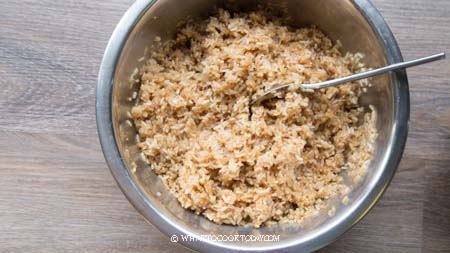
2. COOK THE MEAT FILLING
Preheat a pot or Dutch oven. Add cooking oil and stir fry the garlic until fragrant. Add dried shrimp and stir fry for another minute.
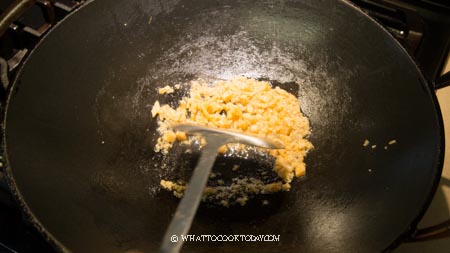
Add the meat and stir fry until the meat turns color.
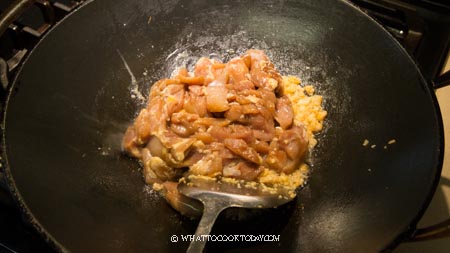
Add water chestnuts and mushrooms. Continue to stir fry until the meat is cooked through
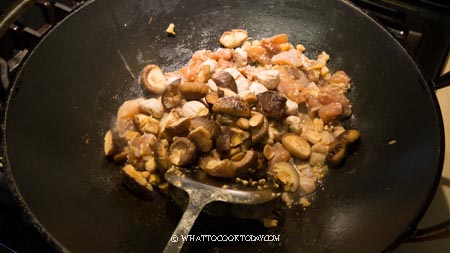
Stir to mix everything.
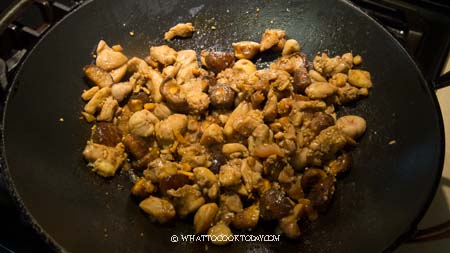
Add Chinese sausage and stir fry for another minute. Have a taste and add more soy sauce or salt to taste. It should be savory in taste.
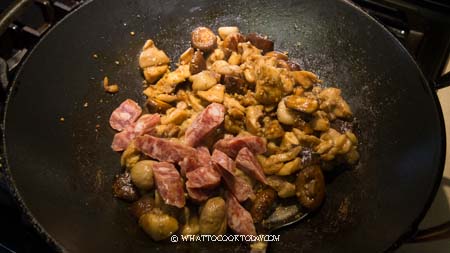
Stir in the crispy shallots (bawang goreng) if using. Dish out and set aside
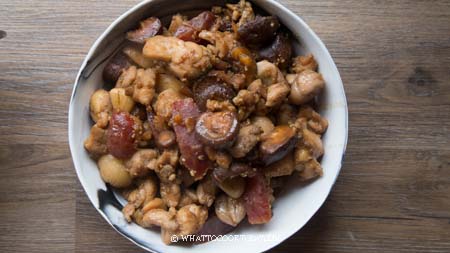
STEP-BY-STEP HOW TO WRAP BAK CHANG (STICKY RICE DUMPLINGS)
1. Stack 2 leaves on top of each other. If you have ragged leaves, you can use another leaf to cover by overlapping them so there won’t be any leakage. Make sure the smooth side of the leaves are facing you
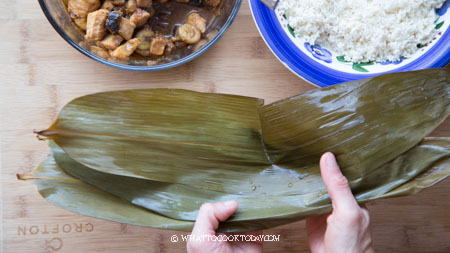
2. Fold into a cone shape
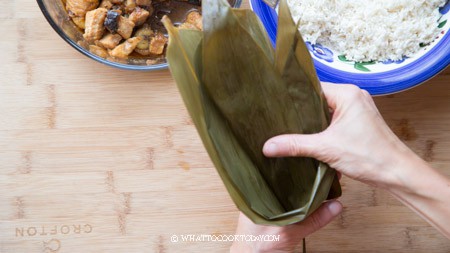
3. Fill it up with about 1 Tbsp of rice and use the back of the spoon to pack it in and slightly create an indentation in the middle for the filling
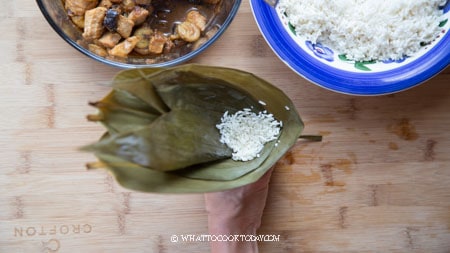
4. Then add chestnuts, mushrooms, Chinese sausage, and few pieces of the meat
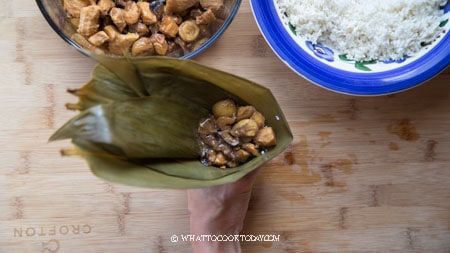
5. Top again with a scoop of rice and press with the back of the spoon to make sure they are tight.
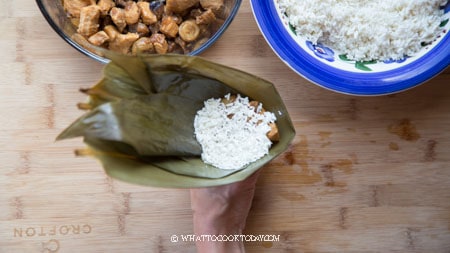
6. Fold one side down
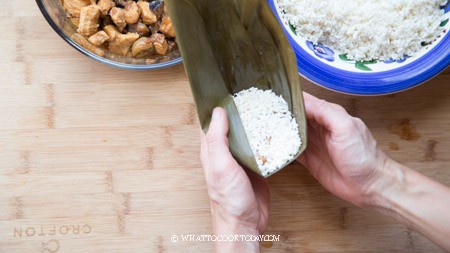
7. Fold the opposite site down
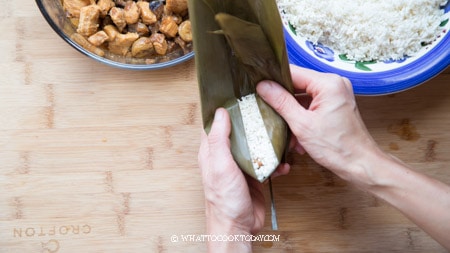
8. Fold the top over
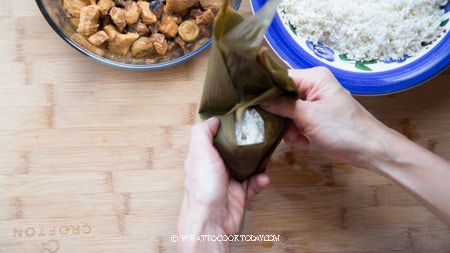
9. This is how it looks like at this point
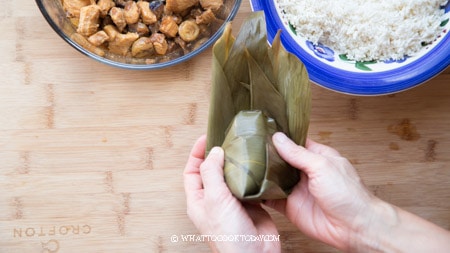
10. Fold the 2 wings over
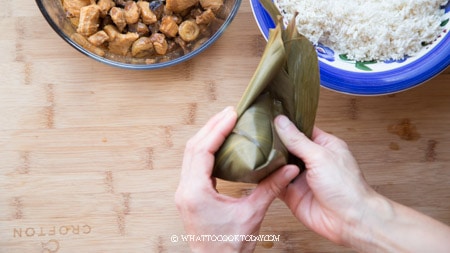
11. Now you have this extra piece
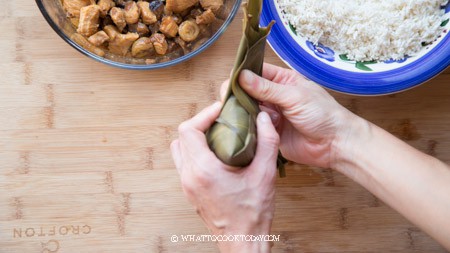
12. Fold it over to either side
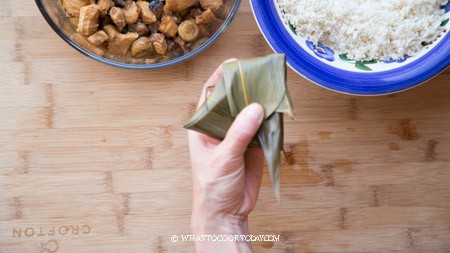
13. Secure with a kitchen twine
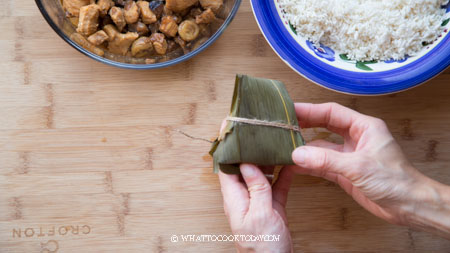
HOW TO STORE AND REHEAT BAK CHANG
You can freeze the bak chang in the freezer and it’s good for 6 months. When ready to eat them, you don’t thaw them. They can go straight from the freezer to the steamer with boiling water and steam for about 10 minutes on high heat or until heated through. You can also reheat them in a microwave on high on 1 minute increment until heated through.
TRY NO-WRAP BAK CHANG TOO
This No-wrap Bak Chang recipe is easy to put together with the same great taste. Thanks to mama for the recipe and thanks Fuschia, for another great story behind this awesome food! I just had a bite and OMG!!!! Superlicious!!!! The sense of satisfaction for being able to eat it and made it from scratch!!!!!
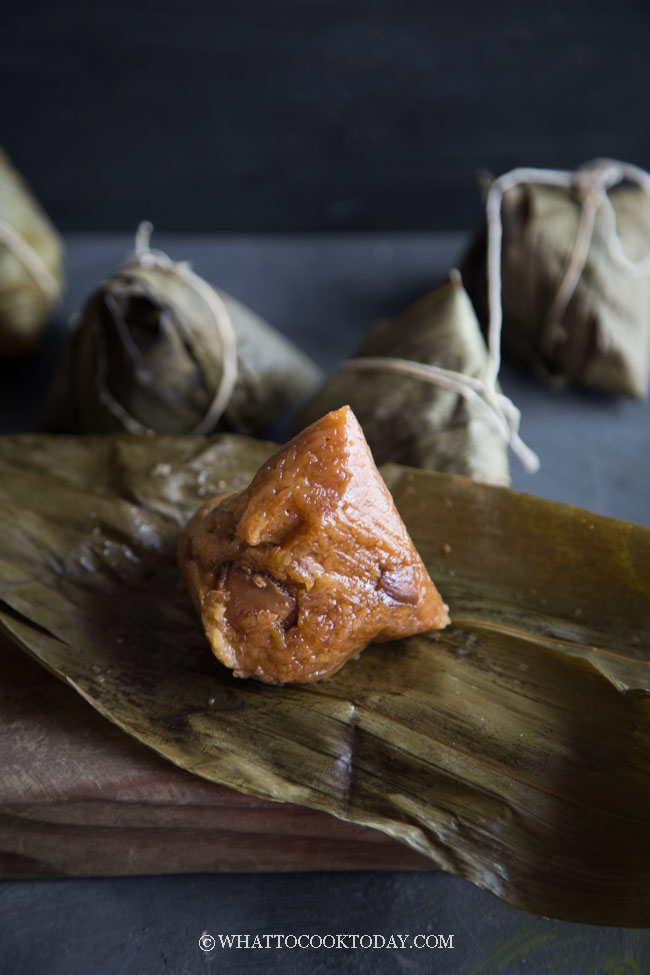
Easy Hokkien Bak Chang Recipe and Video (Zongzi-Sticky Rice Dumplings)
Ingredients
For the rice:
- 500 gr glutinous rice / sweet rice / sticky rice
Seasonings for rice:
- 2 Tbsp cooking oil
- 10 cloves garlic peeled and finely chopped
- 2 Tbsp dark soy sauce or use kecap manis
- 1 Tbsp soy sauce
- 2 Tbsp oyster sauce
- 1 tsp sugar omit if you use kecap manis
Filling:
- 500 gr mixture of pork butt and pork belly cut into 2-inch chunks you can use boneless skinless chicken thighs too
- 4 Tbsp cooking oil
- 6 cloves garlic peeled and finely chopped
- 50 gr dried shrimp soaked and drained off water
- 10 shitake mushrooms soak and keep water and slice into 1/2-inch strips
- 12-15 dried chestnuts
- 2 links Chinese sausage remove casing and slice at angle
- 6 salted egg yolks halved (optional)- I didn't use them this time
- ½ cup fried shallot crisp optional
Marinade for meat:
- 3 Tbsp dark soy sauce you can use kecap manis and omit sugar
- 1 Tbsp soy sauce
- 2 Tbsp oyster sauce
- ¼ tsp ground white pepper
- 1 tsp Chinese five-spice powder
- 1 tsp sugar or more to taste
You also need:
- 24 pieces dried bamboo leaves see notes
- Kitchen twine
Instructions
The day before:
- If you are not using pressure cooker to cook the bak chang, you need to soak the rice for at least 4 hours or overnight. Drain off the water after that
- Soak the bamboo leaves in water and then discard the water and wipe the leaves dry with clean cloth the next day when you are ready to use them
- Place the meat and ingredients for marinade in a large zipper bag or bowl and marinated the meat overnight for best flavor and taste
- Soak the dried chestnuts, mushrooms, and dried shrimp in water separately until soft. I just leave them soaking overnight. Remove the red membrane in chestnuts with a toothpick if you see any. Cut the mushrooms into smaller pieces and finely chop the dried shrimp
Cook the meat filling the day before:
- Preheat a pot or Dutch oven. Add cooking oil and stir fry the garlic until fragrant. Add dried shrimp and stir fry for another minute. Add the meat and stir fry until the meat turns color. Add chestnuts and mushrooms. Continue to stir fry until the meat is cooked through Stir to mix everything. Have a taste and add more soy sauce or salt to taste. It should be savory in taste. Stir in the bawang goreng if using. Dish out and set aside
Stir fry the rice:
- After soaking the rice (if you are not using a pressure cooker to cook the bak chang), drain all water. Preheat a large wok or skillet. Add cooking oil. Stir fry garlic until really fragrant. Add the rice followed by all the seasonings. Stir fry the rice until it picks up all the seasonings and the rice turns slightly sticky. Remove from the heat and let it cool down before using it to wrap
How to wrap zongzi:
- Get the rice, the meat filling and the salted egg yolks (if using) ready for wrapping
- Generally, you will need about 2 leaves, stacking on top of each other. If you have ragged leaves, you can use another leaf to cover by overlapping them so there won't be any leakage. Make sure the smooth side of the leaves are facing you
- Fold into a cone shape. Fill it up with about 2 Tbsp of rice and use the back of the spoon to pack it in and slightly create an indentation in the middle for the filling
- Then add chestnut, mushrooms, sausage, and few pieces of the meat into the cone. Top again with more sticky rice, filling up almost 3/4 of the cone. Make sure you really pack it down so the dumpling will be nice and tight later
- Fold one side down. Fold the opposite site down. Most people don't fold the two sides and go straight to folding the top part down (as shown in the next step). But I feel like this helps me to wrap "neater" and shows the triangle shape better
- Fold the top part down. Fold in both sides. You'll have this extra piece on top now. Simply fold it down to either one of the side
- Tie with a string. Repeat with the rest of the filling and rice
Cooking with Instant Pot pressure cooker:
- Fill up the inner pot halfway with water. Press saute and bring water to a boil. Add 1/2 tsp of salt. Place the bak chang in the inner pot of instant pot. I can cook 12-14 dumplings in my 6-quart instant pot. Top up with more water to make sure it covers the zongzi if necessary
- Cover the lid. Turn the steam release valve to seal. Press "pressure cooker" and make sure it's on "high pressure". Set the timer to 1 hour. Release pressure immediately after that
- Carefully open the lid and use a tong to gently remove the zongzi from the pot to a cooling rack. Let the water drips down. The zongzi will still be soft to touch. I recommend waiting 24 hours before eating them
Boiling on the stove:
- Bring a large pot of water to a boil. Add 1/2 tsp of salt. Place the bak chang in a large pot. Bring it back to a boil and then cover and lower the heat to let it gently boil for the next 2 to 2 1/2 hours. If your bak chang is large in size you may need 3 hours or so. At the end of cooking time, you can take one out to see if it's cooked through. If the rice doesn't stick to the leaves and doesn't fall apart and the rice holds together nicely. It's done. If the rice falls apart, you need to boil them longer
- Carefully use a tong to gently remove the bak chang from the pot to a cooling rack to let it cool down for 24 hours before eating them. They will still be soft to touch, but will firm up once they are cooled down completely
How to store and reheat:
- If you have leftovers, you can freeze the zongzi in the freezer and it's good for 6 months. When ready to eat them, you don't thaw them. They can go straight from the freezer to the steamer with boiling water and steam for about 10 minutes on high heat or until heated through or you can reheat them in a microwave on high on 1 minute increment until heated through
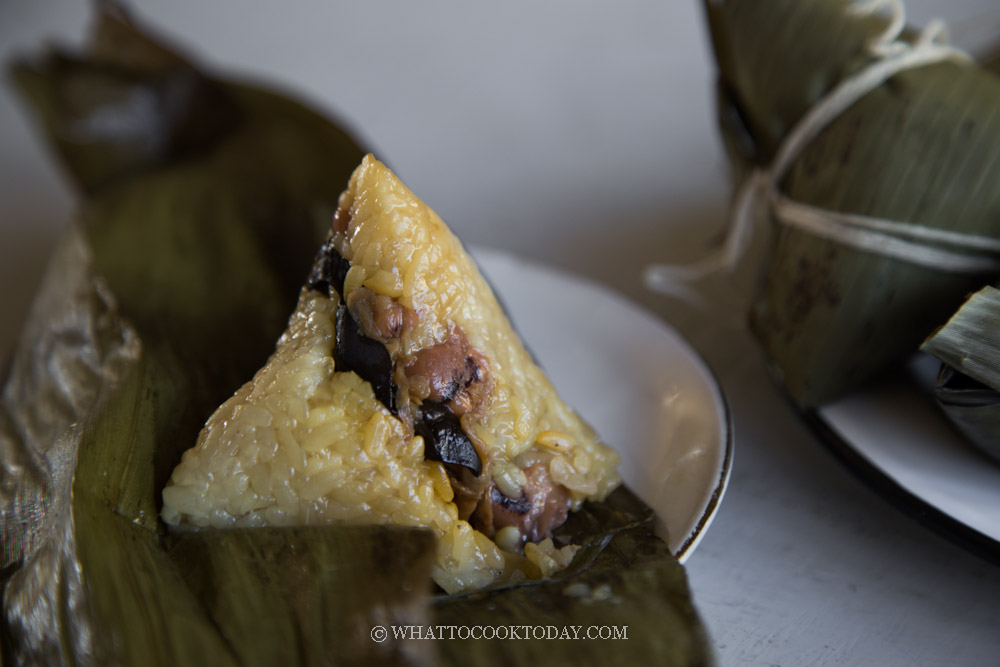



54 comments
Hi again Marvellina,
Something went wrong with my earlier comment, not sure if you received a partial comment but I had not finished what I was saying….
Anyways, just want to ask what you do with the left over bamboo leaves. I over soaked and have lots left still soaking in a basin of water. Can you dry and re-use them ?
Thanks!
Hi Charlotte, yes you dry them and they can be used again 🙂 I usually soak more than I need anyway, in case some of the leaves are torn, etc.
Hi Marv,
It’s that time of the year ,making Zhongzi. I accidentally come across your blog , you r the only person that say to add salt to the boiling water. The first time I made Zhongzi I did not add salt & my Zhongzi was quite tasteless .
The Zhongzi I made is almost similar to your except I added a piece of candied winter melon.
Thanks for sharing your wonderful recipe. Cheers.
Hi Mama Mia, I’m glad zhongzi turned out well for you. Yes, a small pinch of salt can bring out flavor in food 🙂 I love the addition of candied winter melon, similar to Nyonya zhongzi 🙂 Cheers
Do the bamboo leaves have any effect on flavor? Any other leaves I can use?
Hi Kate, yes, not a whole lot, but some. I’ve never tried using other leaves as this is what usually used to wrap sticky rice dumplings. I have made some without any leaves too. https://whattocooktoday.com/no-wrap-pressure-cooker-zongzi.html
Dear Marvellina
Today, I made zongzi using your recipe and the result is simply marvelous. After more than twelve years, I managed to use some of the dried bamboo leaves my mum kept. I’d forgotten to add salt to the boiling water for the first batch of nyonya zongzi yesterday and the rice was tasteless. I put the pressure cooker on 70min and the rice was a bit too soft. Today, I followed the fifty minutes timing and the savory zongzi came out perfect. I managed to get 30 zongzi using your fillings ingredients. Appreciate your recipe, thank you.
Hi Yen, I’m glad you made some zongzi and wow…after 12 years!! I used to never put any salt in the boiling water until somebody (I can’t remember who) told me that she did that and apparently it helps to bring out the flavor of the zongzi. Thank you for your feedbacks 🙂 I’m glad they turned out for you!
Can I opt out the water chestnuts? or may be substitute it with jicama instead? I have soaked the rice. I will be making these beauties tomorrow. =) Thank you for the recipe. =)
Hi Vange, absolutely. The filling choice is quite flexible 🙂 Good luck! I hope you like them 🙂
Hello Marv, thank you so much for sharing the recipe and also the step by step process. You made Bak Chang-making less intimidating! Would it make a difference in the cooking process if I use normal rice instead of glutinuous one? Perhaps the cooking hour if I use pressure cooker? Thank you once again, I am so glad to stumble upon this marvelous website.
Hi Diana, I haven’t tried this before with regular rice. It should work I would imagine. The cooking process will be the same. I’m not exactly sure how long the cooking time going to be, but I don’t think it will take as long as 50 minutes. If I may suggest trying 30 minutes first and see how it goes.
I made it! It came out fabulously. Only the wrapping part was challenging but probably would need practice. Although I didn’t get the perfect pyramid shape but I just enjoy it. Thank you for this recipe.
Yay!! so happy to know that you made it! the wrapping part definitely comes with practice, the more you wrap, you’ll get that perfect pyramid. I couldn’t get that perfect pyramid yet too, not on all of them anyway!